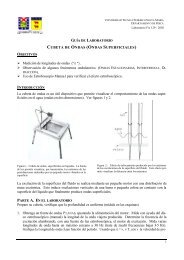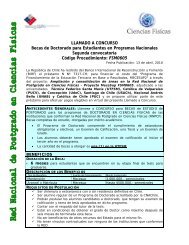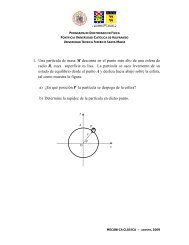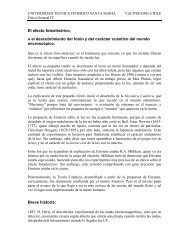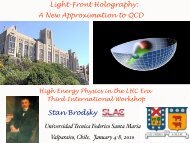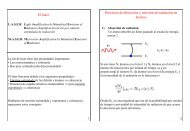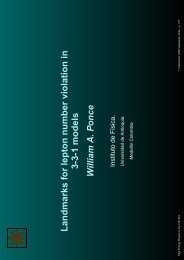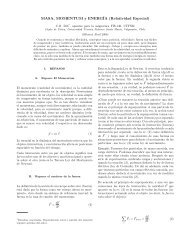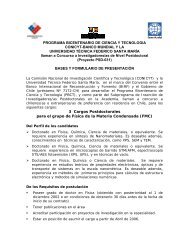Aca - Departamento de Física - Universidad Técnica Federico Santa ...
Aca - Departamento de Física - Universidad Técnica Federico Santa ...
Aca - Departamento de Física - Universidad Técnica Federico Santa ...
Create successful ePaper yourself
Turn your PDF publications into a flip-book with our unique Google optimized e-Paper software.
V Encuentro Sud Americano <strong>de</strong> Colisiones Inelásticas en la Materia<br />
Supression of binary and recoil peaks in ionization of H 2 by electron impact<br />
Fojón O A, Stia C R and Rivarola R D<br />
Instituto <strong>de</strong> <strong>Física</strong> Rosario (CONICET-UNR), Pellegrini 250 (2000) Rosario, Argentina<br />
email address corresponding author: fojon@ifir-conicet.gov.ar<br />
We study theoretically the single<br />
ionization of H 2 molecules by fast electron<br />
impact. Our aim is to show that interferences<br />
coming from the coherent emission from the<br />
molecular centers may produce unexpected<br />
consequences in the physical features of the<br />
observables of the reaction.<br />
Interference phenomena have been of<br />
crucial importance in the foundation of quantum<br />
mechanics. Analogies with the Young two-slit<br />
experiment played a fundamental role in the<br />
<strong>de</strong>scription and comprehension of the dual<br />
nature of quantum objects such as electrons. A<br />
fascinating alternative way of observing<br />
interference patterns is provi<strong>de</strong>d by the electron<br />
spectra resulting from the ionization of<br />
molecular diatomic targets. In the sixties, it was<br />
suggested that the coherent emission from these<br />
molecules may give rise to specific oscillations<br />
in the differential cross sections of the ejected<br />
electrons, the two molecular centers acting as the<br />
analogues of the two slits in the Young<br />
experiment [1]. However, this kind of<br />
oscillations was measured for the very first time<br />
with fast krypton ions impacting on H 2 [2]. In<br />
previous works, we have shown that these<br />
interference patterns may be observed also for<br />
electron impact [3-7].<br />
We focus here on electron emission at<br />
high impact energies from fixed-in-space H 2<br />
molecules impacted by fast electrons. We study<br />
transitions at fixed equilibrium internuclear<br />
distance from the ground state of H 2 to the<br />
ground (gera<strong>de</strong>) and first excited (ungera<strong>de</strong>)<br />
state of the H +<br />
2 residual target. We consi<strong>de</strong>r<br />
coplanar geometries in which the inci<strong>de</strong>nt,<br />
scattered and ejected momenta lie all in the same<br />
plane. In addition, we analyze asymmetric<br />
kinematics situations in which one slow and one<br />
fast electron are <strong>de</strong>tected in the final channel.<br />
We employ a first or<strong>de</strong>r mo<strong>de</strong>l obtained<br />
in the framework of a two-effective center<br />
approximation (TEC). The i<strong>de</strong>a exploited in the<br />
TEC mo<strong>de</strong>l is that although electrons in the<br />
ground state of H 2 are shared by both nuclei, the<br />
electronic <strong>de</strong>nsity is peaked at the nuclei<br />
positions. Then, it is argued that ejection occurs<br />
in the neighbourhoods of one nucleus while the<br />
nuclear charge of the other one is screened<br />
completely by the non ionized electron.<br />
Consequently, a unique final effective<br />
continuum function satisfying the correct<br />
asymptotic long range conditions is used to<br />
represent the ejected electron in the final channel<br />
of the reaction. This mo<strong>de</strong>l gives reasonably<br />
good agreement with experiments [8]<br />
constituting thus a good approximation to the<br />
final state of the reaction in which three charged<br />
bodies interact through Coulomb potentials. In<br />
or<strong>de</strong>r to take into account the complexities of<br />
this interaction in an approximate way, one can<br />
take a more elaborated final function such as the<br />
one used in Ref. [9]. This function <strong>de</strong>scribes the<br />
final interactions through a product of three<br />
Coulomb functions associated to the three twobody<br />
pairs present in the final channel. The<br />
approximation obtained using this function for<br />
molecular targets gives an excellent agreement<br />
with experiments [10].<br />
We show here for the first time that un<strong>de</strong>r<br />
<strong>de</strong>finite conditions, <strong>de</strong>structive interferences<br />
coming from the coherent emission from both<br />
molecular centers provoke the supression of the<br />
binary peak in the multiple differential cross<br />
sections corresponding to transitions leading to<br />
final ground state of H 2 + . This is a surprising<br />
result as is well known that ejection is classically<br />
more likely to be produced in the binary region.<br />
Moreover, this finding is shocking as so far and<br />
up to our knowledge the presence of the binary<br />
peak was assumed for every ionization reaction<br />
with either atomic or molecular targets [11].<br />
57 Valparaíso, Chile



